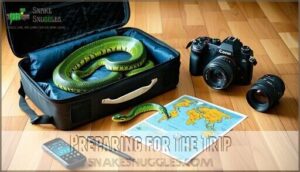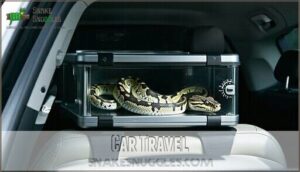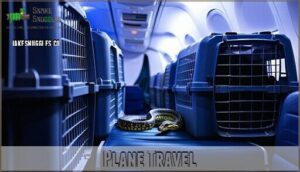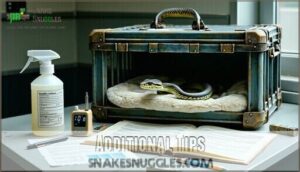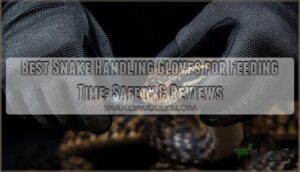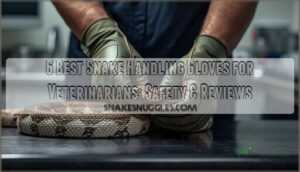This site is supported by our readers. We may earn a commission, at no cost to you, if you purchase through links.
 Traveling with your snake isn’t rocket science, but it does require smart planning.
Traveling with your snake isn’t rocket science, but it does require smart planning.
You’ll need a secure, ventilated container that maintains stable temperatures throughout your journey.
Research local laws first—many states have strict rules about exotic pets crossing borders.
Get a health certificate from your vet, and pack familiar bedding to reduce stress.
Car travel works best since you control the environment, but airlines have specific reptile policies if flying is necessary.
Keep your snake’s routine as normal as possible, monitor temperatures constantly, and never leave them unattended in vehicles.
The secret lies in understanding your snake’s specific needs during transport.
Table Of Contents
- Key Takeaways
- How to Travel With a Snake?
- Preparing for The Trip
- Transporting Your Snake
- Arrival and Settling In
- Additional Tips
- Frequently Asked Questions (FAQs)
- How to transport a pet snake?
- How to travel with a snake?
- How do you keep a snake calm during travel?
- How do you keep a snake from slipping through a carrier?
- How to transport a snake on a plane?
- Can You Fly with a pet snake?
- What is the best way to transport a snake?
- How to keep a snake warm while traveling?
- Can you free roam a snake?
- What to do if a snake is in my car?
- Conclusion
Key Takeaways
- You’ll need legal clearance first – Research destination laws, get required permits, and schedule a vet checkup for health certificates before you travel with your snake.
- Temperature control isn’t optional – Maintain 75-85°F consistently using heating pads, avoid direct sunlight, and pack cooling/heating supplies based on your travel climate.
- Choose the right transport method – Car travel gives you better environmental control, while airline cargo requires advance booking and approved containers since snakes can’t fly in cabins.
- Plan for post-travel recovery – Wait at least seven days before feeding, minimize handling, and let your snake acclimate to the new environment to reduce stress-related health issues.
How to Travel With a Snake?
Traveling with snakes requires careful planning and legal compliance.
You’ll need to research destination laws, choose appropriate carriers, and consider your snake’s temperament before hitting the road.
Safe snake travel depends on proper temperature control, emergency planning, and understanding species considerations.
Whether you’re relocating or vacationing, successful snake travel starts with thorough preparation and travel insurance coverage.
Preparing for The Trip
Preparing for a snake travel adventure requires more planning than packing your own suitcase.
You’ll need to research destination laws, schedule a vet visit, and gather the right supplies to keep your scaly friend safe and comfortable during the journey, which involves considering various factors for a successful trip with your scaly friend.
Research Local Laws
Before you hit the road with your scaly companion, you’ll need to navigate the legal landscape like a detective.
Snake travel regulations vary dramatically between locations, so don’t get caught off-guard. Remember that snake ownership regulations differ by state.
Check these essential requirements:
- Permit requirements and species restrictions for your destination
- Quarantine regulations and import/export laws that apply
- Venomous species bans and exotic pet laws in each state you’ll cross
Vet Checkup
Schedule a Pre-Travel Exam with your snake veterinarian before any journey. This vital step guarantees your pet’s travel readiness and helps secure necessary documentation.
- Parasite Screening – Test for internal and external parasites that could worsen during travel stress
- Hydration Assessment – Verify proper fluid levels and overall body condition
- Respiratory Health – Check for any breathing issues that altitude or temperature changes might aggravate
- Quarantine Period – Discuss isolation requirements and obtain your snake health certificate for legal compliance
The steps outlined are crucial for ensuring the health and safety of your snake during travel, and compliance with legal requirements.
Packing Supplies
Pack up the right gear to keep your snake secure and comfortable during travel.
Your snake travel carrier selection matters – choose containers that balance safety with your pet’s needs. A suitable carrier can be found at a snake travel carrier store.
Essential packing supplies include:
- Snake carrier – A sturdy pillowcase or specialized snake bag for primary containment
- Travel containers – Lock-top plastic totes with proper ventilation needs and absorbent linings
- Heating pads – Temperature control equipment and security measures like extra clips
Transporting Your Snake
Moving your snake requires different approaches depending on whether you’re driving or flying.
You’ll need the right container, proper temperature control, and knowledge of specific rules for each type of travel, including complete concepts such as understanding the mode of transport.
Car Travel
When car travel beckons, your snake’s comfort becomes priority one. Pack essentials: 1) Well-ventilated, secure snake carrier 2) Temperature control heating/cooling source 3) Water dish.
Maintain snake temperature control between 75-85°F, avoiding direct sunlight. Minimize jostling during snake travel with stable positioning.
Take travel breaks to check your pet. Snakes may even enter through the car’s undercarriage access points.
Watch for stress signs—heavy breathing or striking behavior, as these indicate your snake needs extra care during travel.
Plane Travel
Airline regulations ban snakes from cabins—they must travel in cargo.
Research each airline’s snake policy, as TSA regulations prohibit reptiles in carry-on bags.
Your snake travel container needs secure ventilation, proper size, and "Live Animal" labels.
Consider an airline approved carrier for safe transport.
Temperature control becomes essential during air travel.
Heat packs help maintain warmth, while stress reduction techniques like covering containers create den-like environments for calmer flights, ensuring a safe transport and reducing animal stress.
Hotel Stays
Hotels and snake travel don’t always mix. Many hotel policies ban reptiles outright, so call ahead to avoid surprises.
Once you’re settled, focus on snake security and room safety.
- Be upfront with staff interactions – honesty prevents awkward confrontations later
- Secure your snake enclosure – housekeeping shouldn’t get any unwelcome surprises
- Have an emergency protocol ready – because Murphy’s Law loves snake comfort zones
Arrival and Settling In
Once you’ve reached your destination, your snake needs time to recover from the stress of travel before you can set up its permanent home.
You’ll want to let your pet rest in its travel container for a few hours, then gradually introduce it to the new environment to help it adjust safely.
You’ll be introducing your snake to a new environment.
Setting Up The New Home
Once you’ve arrived safely, recreate your snake’s familiar environment quickly.
Set up the enclosure with proper temperature gradient zones—warm and cool sides matter. Install hiding spots on both ends so your pet feels secure.
Place a clean water source within easy reach. A proper setup requires attention to terrarium snake supplies.
Don’t rush the first feeding; wait until your snake shows interest in food naturally. This approach helps ensure a smooth transition and reduces stress.
Acclimating Your Snake
How does your snake bounce back after the journey? Patience becomes your best friend during this vital adjustment period. Your scaly companion needs time to decompress from travel stress and adapt to new surroundings.
Follow these essential acclimation steps:
- Wait at least seven days before offering food – rushed feeding often leads to regurgitation
- Maintain consistent temperatures for proper temperature regulation and stress reduction
- Minimize handling and disturbances to allow natural snake acclimation processes
Don’t panic if your snake refuses meals initially. This behavior’s completely normal after relocation. Remember to provide a secure lid to prevent escapes. Focus on creating a calm environment with proper hiding spots. Your patience during this snake travel acclimation phase guarantees long-term success.
Additional Tips
Beyond the basics of transport and setup, you’ll want to keep a few extra considerations in mind to make your snake’s journey as smooth as possible.
These final tips cover stress reduction, climate factors, and legal requirements that can make or break your travel plans.
The goal is to ensure a smooth journey by considering all relevant factors, including climate factors and legal requirements.
Minimize Stress
Travel stress hits snakes harder than you’d think.
Your pet’s well-being depends on smart stress management throughout the journey.
Here’s how to keep your snake calm:
- Carrier Acclimation – Introduce your snake to its travel container weeks before departure
- Gradual Introduction – Practice short trips around your home first
- Secure Enclosure – Use escape-proof containers with proper ventilation
- Temperature Control – Maintain consistent warmth with heating pads
- Post-Travel Monitoring – Watch for signs of illness after arrival
Consider Climate
Climate plays a huge role in your snake’s comfort during travel. Temperature regulation becomes your top priority since snakes can’t control their body heat like you can.
**Climate control isn’t optional when traveling with snakes—it’s literally a matter of life and death for your cold-blooded companion.
Here’s your climate checklist:
- Pack heating pads for cold weather conditions and cooling packs for hot climates
- Monitor humidity control with a portable hygrometer throughout your journey
- Make seasonal adjustments to your travel schedule during extreme weather
- Create microclimate conditions inside the carrier with proper insulation
Geographic considerations matter too – desert heat requires different prep than mountain cold.
Check Local Laws
Research your destination’s exotic pet laws before packing up your serpent friend.
What’s legal in your current state might be forbidden elsewhere, turning your dream move into a legal nightmare. Snake laws vary substantially by state.
Double-check these four areas:
- State Regulations – Individual state laws vary wildly for snake ownership
- City Ordinances – Local municipalities often have stricter rules
- Venomous Species restrictions and permit requirements
- Ownership Restrictions based on size or species classification
Frequently Asked Questions (FAQs)
How to transport a pet snake?
Ironically, your slithery friend needs more travel prep than you do.
Use a secure, ventilated container like a pillowcase inside a plastic tub.
Keep temperatures steady and avoid feeding 48 hours beforehand.
How to travel with a snake?
Pack your snake in a secure, ventilated container like a pillowcase inside a plastic tub.
Keep temperatures between 70-85°F, avoid direct sunlight, and check airline policies since most require cargo shipping.
Ensure all instructions are followed carefully to guarantee safe transport.
How do you keep a snake calm during travel?
Your snake isn’t planning a vacation playlist, but it needs zen mode.
Use a dark pillowcase, cover the carrier with blankets, and maintain warm temperatures.
Darkness reduces stress better than snake yoga.
How do you keep a snake from slipping through a carrier?
Choose carriers with no gaps larger than your snake’s smallest body part.
Use zip ties or cable ties to secure doors and seams.
Line containers with grippy materials like towels to prevent sliding around.
How to transport a snake on a plane?
Flying with your slithery companion is like traversing a maze of red tape.
You’ll need to ship your snake as cargo since airlines ban cabin transport.
Book American or Delta, use approved containers, and expect $200+ fees.
Can You Fly with a pet snake?
You can’t bring your pet snake in the cabin on any airline.
Most carriers require snakes to travel as cargo only, with strict container requirements and advance booking.
Check specific airline policies before planning your trip.
What is the best way to transport a snake?
Use a secure, well-ventilated container that’s escape-proof and appropriately sized.
Place your snake in a pillowcase first, then into the carrier with absorbent lining.
Keep temperatures between 70-85°F and minimize handling during transport.
How to keep a snake warm while traveling?
Like wrapping a beloved pet in your favorite blanket, you’ll want to maintain your snake’s cozy environment.
Pack heat packs, insulated carriers, and extra towels.
Keep temperatures between 75-80°F, avoiding direct sunlight or air conditioning vents to ensure a stable and cozy space for your snake.
Can you free roam a snake?
You shouldn’t free roam your snake unsupervised.
Snakes can hide in tight spaces, escape outdoors, or get injured.
Supervised exploration in snake-proofed rooms works, but secure enclosures remain safest for your pet’s wellbeing.
What to do if a snake is in my car?
Like finding an unwelcome hitchhiker, stay calm and don’t panic.
Pull over safely, exit your vehicle, and call animal control or a local wildlife expert.
Don’t attempt to handle the snake yourself—professionals know best.
Conclusion
Surprisingly, many snake owners discover that learning how to travel with a snake becomes second nature after their first successful trip.
You’ve got the knowledge to keep your scaly companion safe and comfortable during transport.
Remember to prioritize legal compliance, temperature control, and stress reduction throughout your journey.
With proper preparation and the right supplies, you’ll confidently navigate any travel situation, and your snake will appreciate the careful planning, and you’ll enjoy peace of mind knowing you’re prepared.
- https://www.theatlantic.com/technology/archive/2013/01/truth-about-snake-plane-according-science/319574/
- https://www.cbsnews.com/news/snake-tampa-international-airport-tsa-emotional-support-animal/
- https://www.aa.com/i18n/travel-info/special-assistance/pets.jsp
- https://dec.alaska.gov/eh/vet/import-export/pets/
- https://www.animalplanet.com/pets/why-do-snakes-need-ventilation

